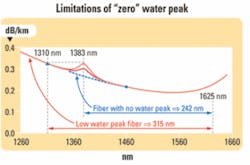Low versus no water peak in optical fiber
by Laurent Gasca, Gerard Kuyt, and Ryan Chappell
Several telecommunication transmission bands have been defined and standardized—from the original O-band to the U/XL bands (see table). The U/XL-bands and E-band have typically been avoided because they are associated with high transmission-loss regions. The U/XL band, residing at the very end of the transmission window for silica glass, has inherently high transmission losses.
The E-band represents the water peak region where a standard fiber is most affected by attenuation caused by hydroxyl ions present within the glass core structure. Today, however, optical fiber manufacturers have dramatically reduced the losses in the E-band. This article will address how this issue is being further reduced to enable use of the E-band for effective transmission.
Manufacturers, system providers, and end-users have worked together to deal with the water peak region issue. Together, they have reached agreements to define and establish industry standardization for water-peak performance of optical fiber within the latest singlemode standards—the International Telecommunication Union-Telecommunicationâ��s (ITU-T) G.652D and International Electrotechnical Commissionâ��s (IEC) B1.3.Since 1310-nm attenuation is the transmission-limiting wavelength of low or zero water-peak fibers, as shown by the spectral attenuation plot in the figure, the standards require that the water-peak attenuation at 1383 nm (after H2-aging) be equal to or lower than that at 1310 nm. Therefore, the reasonable conclusion is that transmission reach is limited by the wavelength with the highest attenuation. The result is a specification for 1383 nm that is in the range of 0.32 to 0.34 dB/km.
Depending on their marketing strategies, manufacturers may brand their fibers as "zero" water peak or as "low" water peak. However, the use of "zero" combined with statements about the "elimination of loss" at the water peak should not lead users to believe that attenuation has been eliminated at the water-peak wavelength. In reality, water-peak fiber designs have additional loss due to the OH radical absorption. When taken into account with other sources of loss associated with real-life configuration (i.e., after aging), the actual measurement of "zero" water peak is never exactly equal to zero.Some fiber manufacturers also claim that service providers will achieve up to 12% more reach and service areas can increase up to 27% when deploying "zero" water-peak fiber in lieu of "low" water-peak fiber. However, such statements only hold true for systems that operate solely in the water peak region (E-band) and do not use 1310 nm or below (O-band). No such systems exist in the real world, since the 1310-nm wavelength is one of the most commonly used areas within the transmission window. From both an economic and environmental standpoint, it is simply not feasible to operate only in the E-band. In fact, the use of the E-band is typically limited to providing an extension of the O-band. The limiting parameter would, therefore, be the 1310-nm loss value.
Another argument offered in favor of "zero" water peak over "low" water-peak fiber pertains to the use of distributed Raman amplification in the C-band. In this scenario, the pump wavelength would be in the 1440-nm region. In truth, however, the real expectations for Raman applications in the C-band are very low: EDFAs have proven far more convenient. Raman amplification is occasionally used in the C-band as a complementary amplification means for long hops or "span-masking." It could also be reconsidered in the L-band, but then the wavelength pump would be in the 1485-nm wavelength region where the influence of the water peak is extremely low. For example, reducing the 1383-nm peak from 0.32 to 0.30 dB/km would lead to a minimal improvement of less than 0.001 dB/km at 1485 nm.1 At 1440 nm, the same 1383-nm reduction would achieve an improvement of 0.002 dB/km, which is also negligible.
As already stated, the only reasonable conclusion is that transmission reach is limited by the wavelength with the highest attenuation. Therefore, to leverage a 1383-nm attenuation (water peak) lower than that at 1310 nm, one should not use the part of the wavelength band with higher attenuation. As shown in the figure, the extreme case of a fiber with no water-peak leads to a reduction of the total transmission window by 25%.
The pursuit of perfection with no practical roots has come to an end in our industry. Everything has a cost—even from an environmental point of view. With that in mind, supporting the race toward ever-decreasing water peak is not practical. The result is both a waste of effort as well as an unnecessary depletion of energy and drying gas, such as chlorine. Rather, the industry should be fully supporting the standardization bodiesâ�� logic that defines the right attenuation level as 1310 nm.
In making any decision to select an optical fiber type, you should be well informed and understand the various brand names and performance claims. Unless a system is designed to operate only at 1383 nm (E-band), there is no advantage in choosing a "zero" water-peak fiber over a "low" water-peak fiber. The reach-limiting wavelength is 1310 nm and, therefore, 1310-nm attenuation will dictate the system�s limitation.
Laurent Gasca and Gerard Kuyt are product line managers at Draka (www.draka.com), based in France and The Netherlands.Ryan Chappell is Draka�s North American fiber business manager.
1. Bredol M., Leers D., Bosselaar L. and Hutjens M., "Improved model for OH absorption in optical fibers," Journal of Lightwave Technology, vol. 8, issue 10, pp. 1536-1539 (1990).


